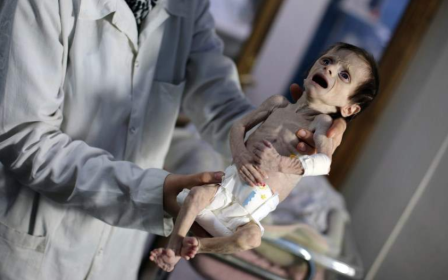Both sides committed war crimes during Eastern Ghouta siege: UN

Syrian government troops and affiliated forces committed war crimes and crimes against humanity in their long siege of Eastern Ghouta through heavy bombardment and "deliberately starving" 265,000 people, UN investigators said on Wednesday.
About 20,000 rebel fighters entrenched in the besieged area, some belonging to "terrorist groups", shelled the nearby capital of Damascus in attacks that killed and maimed, amounting to war crimes, they said.
The latest report by the UN Commission of Inquiry on Syria, released on Wednesday, is based on 140 interviews as well as photographs, videos, satellite imagery, and medical records.
The investigators also slammed the widespread use of sieges throughout Syria's seven-year conflict, which has killed more than 350,000 people.
"Hundreds of thousands of Syrian women, men and children countrywide have suffered for too long the perverse and long-lasting effects of this medieval form of warfare," the report said.
Set up in 2011 shortly after the civil war began, the commission has repeatedly accused the warring parties of crimes.
'Surrender or starve'
The siege in Eastern Ghouta started in April 2013 when pro-government forces encircled the enclave and "laid the longest running siege in modern history, steadily wearing down both fighters and civilians alike through a prolonged war of attrition", the report said.
From February to April 2018, their tactics to recapture the enclave were "largely unlawful in nature, aimed at punishing the inhabitants of eastern Ghouta and forcing the population, collectively, to surrender or starve".
"Through the widespread and systematic bombardments of civilian inhabited areas and objects, and the continued denial of food and medicine to besieged civilians during the period under review, pro-government forces perpetrated the crime against humanity of inhumane acts causing serious mental and physical suffering," the report said.
Syrian and Russian air forces controlled the skies over Ghouta and carried out heavy air strikes on residential areas where families huddled in dark, overcrowded basements lacking toilets, according to the report. Warplanes hit hospitals, depriving the wounded of health care, it said.
"This pattern of attack strongly suggests that pro-government forces systematically targeted medical facilities, repeatedly committing the war crime of deliberately attacking protected objects, and intentionally attacking medical personnel."
The UN experts cited evidence that chlorine had been used in Ghouta at least four times this year but said their investigations continued.
'Brutal acts of reprisal'
Armed groups including Jaish al-Islam, the region's largest; Faylaq al-Rahman; Ahrar al-Sham and Hay’at Tahrir al-Sham exercised control over Ghouta.
They operated tunnels and deep trenches, and regularly arrested and tortured members of religious minority groups, the report said.
Government attacks were "regularly met with brutal acts of reprisal", it said, saying the rebels' use of improvised rockets that could reach parts of Damascus aimed to "spread terror".
"Even if pro-government forces are bombing and starving the civilian population of eastern Ghouta into submission, there can be no justification for the indiscriminate shelling of civilian inhabited areas in Damascus," commission panel member Hanny Megally said in a statement.
By mid-March, pro-government forces implemented negotiated local truces and "evacuation agreements", the report said.
Tens of thousands left through humanitarian corridors amid the chaos and many civilians remain "interned" by government forces in sites throughout the Damascus area, the report said.
New MEE newsletter: Jerusalem Dispatch
Sign up to get the latest insights and analysis on Israel-Palestine, alongside Turkey Unpacked and other MEE newsletters
Middle East Eye delivers independent and unrivalled coverage and analysis of the Middle East, North Africa and beyond. To learn more about republishing this content and the associated fees, please fill out this form. More about MEE can be found here.




